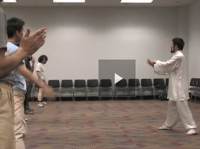Key words: six sealing four closing, generation and transmission of power.
-When we see Master demonstrates moves using tools such as sticks, rubber cord, tables etc. we should act it out, replicate it word for word. It is not just a teaching method; it is how we should actually do it.
-To experience what not moving is. Block touching coat, arm out, chest not responding, the inside never moved.
-Six sealing four closing. Someone holds two sides of your armpit, stretch the armpit to open, only use the armpit. The chest does not move with the arm, power bypass the chest. 1. two hands find the track, have the overall movement. 2. what is fajin. Find the zone. On a certain point, one part accelerates, one part does not follow/move (it is locked/still). We practiced torso staying still, only use the elbow to drive the hand with fajin (shoulder does not get involved either), hands stay on the track. Only when we can rotate the torso, we can add the rotation. Movements make you lose power, rotation is not a movement.
-Generation and transmission of power. A standard way for power transmission in Taiji, back foot-knee-kua/dantian-front shoulder-front hand. Power generation requires 100% separation. Like the car structure is dead, nonmoving and solid, the gasoline is not part of the car structure, the power is from the gasoline burning. It is the nonexistence, qi generating pure energy. Arm is a structure, arm itself does not generate power, something else generates power using the arm as a structure. We do not use the body to generate power in the body/move the body. It is the physics of Taiji. Like you are standing on a cliff, the power of the cliff is not on you. The body is a solid substance, the drop has nothing in it, it is yin yang separation, the clearance. We generate power that never been generated in the body before. Waving arms move is not attached to the body, torso is locked. Master told the pray story about Hong and Feng. True Taiji ability is so dramatic that people don’t regard it as normal. It is supernatural. Hong is through total training/manipulation of the body, to be like a machine, that you are so well/highly coordinated (there is anchor, there is action). Feng is the spirit comes to you through mingmen. It is way more than science, and it is not that simple like qi either. It is a skill. Like gymnastics or walking on a rope. It becomes uncommon.
The generation of power is total yin yang separation. Can be from the kicking of the foot, does not have to be strong, it is how good you are at it. Master showed first toss the body. Then tapping the floor with rear foot while the hands go out. Then add stretch to it, then more stretch and less loss. Master then showed how small the movements of the feet can be in moving/shuffling steps. The feet never leave the floor. The sliding motion creates space to generate power. Not on (self moving), not off (too much gap). We need to replicate this into every joint. The movements in the joints are small. The piston in the car engine, there is no gap/slack. Peng is you are always ready. Elbow strike, one part does not move, another part hits it. R arm placed like a nail, L hand/back foot is the hammer.
-We exercise each part of the body rather than moving as one piece. Ground dragon, the L arm does not move, it is pushed/poked forward and through by the rotation of the body and the back elbow, it is a stick. The arm also does not bend by itself, it is the body comes to the arm on the stepping.
-Form 79 and form 81. Rotate on central axis, two feet adjust. Two kuas rub the torso, creating centrifugal force with the arms attached/linked to it. It is like the blender, the blade does not move. We change the body to a grinder, and arms and legs are weapons. We don’t step, we pivot and rotate to cover distance (using shoulder-kua line as axis). No animal moves, but mechanical moves


